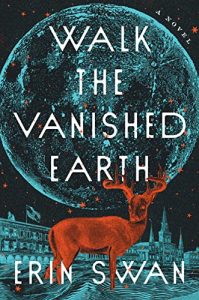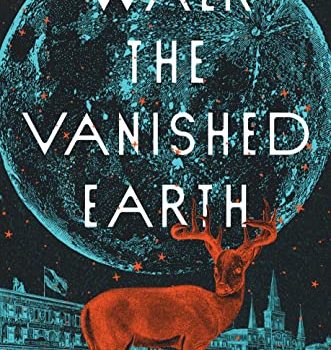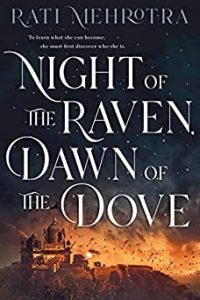Gary K. Wolfe Reviews Walk the Vanished Earth by Erin Swan
 Walk the Vanished Earth, Erin Swan (Viking 978-0-59329-933-3, $27.00 384pp, hc) May 2022.
Walk the Vanished Earth, Erin Swan (Viking 978-0-59329-933-3, $27.00 384pp, hc) May 2022.
Earlier this year, in reviewing Emily St. John Mandel’s Sea of Tranquility, I thought I’d detected a growing trend of fiction that not only blurs the traditional divide between mainstream and genre, but does so in a particular way, with multiple timelines that range from historical settings to current or near-futures and more distant apocalyptic visions.
Matt Bell’s Appleseed, for example, moved from 18th-century Ohio to the late 20th century and then to a thousand or so years later, while Sea of Tranquility included 1912 Canada and a contemporary setting before vaulting ambitiously into the 23rd and 25th centuries. David Mitchell’s Cloud Atlas – now closing in on two decades old – may not have started this trend, but probably went a long way toward making a thing of it. Now we have Erin Swan’s almost equally ambitious first novel, Walk the Vanished Earth, which takes us from 1870s Kansas through 1970s Kansas City and post-Katrina New Orleans to a dying Martian settlement in 2073. As with such earlier hybrids (Ted Gioia calls them ‘‘conceptual fiction’’), it’s characterized by some stunning prose, a deep commitment to family and tradition, and a fair bit of wobbliness on the SF end.
Swan’s fictional family tree is Faulknerian in its complexity. We first meet its paterfamilias, Samson, as a young buffalo hunter in 1873 Kansas. A century later, a pregnant and amnesiac orphan named Bea – who will prove to be by far the most interesting character in the book – wanders into Kansas City, and eventually falls under the care of a psychiatrist named Carson. A couple of decades further on, another orphan, a university student named Paul, receives a mysterious letter leading him to discover his own long-lost mother. Still later, after Katrina has devastated New Orleans, Paul, now married and the father of a troubled daughter named Kay, becomes obsessed with designing an elevated city to protect against such flooding. After Kay grows up – and following still more climate disasters – she and her father nearly make a reality of his dreams, creating a kind of environmental ‘‘Floating City’’ commune in New Orleans. But as the world continues to deteriorate, Kay joins other climate refugees in a redoubt called the Northern Refuge, from which her own daughter eventually becomes one of the first colonists on Mars. (Explaining all these family relationships in any further detail might be viewed as something of a spoiler, but Swan succeeds in making the whole thing work as an almost mournful family saga.)
Interspersed with these chapters of family history and environmental catastrophe are chapters devoted to Moon, a young woman who seems to be the only surviving Martian colonist, except for her two mysterious guardians, known only as Uncle One and Uncle Two. All seem to have undergone genetic or biomedical modifications to survive unaided on the Martian surface, though Swan doesn’t offer much in the way of detail about how this might have been done or by whom. She also glosses over the question of how anyone on a depleted and chaotic Earth could gather the massive resources needed for a successful Mars mission, let alone building a colony. Despite the lack of attention to such details, a long series of short chapters detailing an almost interminable foot journey across the Martian surface echoes what has become an almost standard feature of Martian hard SF. In one sense, all this is only marginally relevant, since Mars is as much a metaphorical space as Swan’s jerry-built Floating City – and just as much another apparent dead-end for her recurring figures of lonely young women seeking their histories. Such characters, along with Swan’s often gorgeous prose, lend a haunting resonance to Walk the Vanished Earth, which can work beautifully as a dreamlike saga, as long as we don’t ask too many questions.
Gary K. Wolfe is Emeritus Professor of Humanities at Roosevelt University and a reviewer for Locus magazine since 1991. His reviews have been collected in Soundings (BSFA Award 2006; Hugo nominee), Bearings (Hugo nominee 2011), and Sightings (2011), and his Evaporating Genres: Essays on Fantastic Literature (Wesleyan) received the Locus Award in 2012. Earlier books include The Known and the Unknown: The Iconography of Science Fiction (Eaton Award, 1981), Harlan Ellison: The Edge of Forever (with Ellen Weil, 2002), and David Lindsay (1982). For the Library of America, he edited American Science Fiction: Nine Classic Novels of the 1950s in 2012, with a similar set for the 1960s forthcoming. He has received the Pilgrim Award from the Science Fiction Research Association, the Distinguished Scholarship Award from the International Association for the Fantastic in the Arts, and a Special World Fantasy Award for criticism. His 24-lecture series How Great Science Fiction Works appeared from The Great Courses in 2016. He has received six Hugo nominations, two for his reviews collections and four for The Coode Street Podcast, which he has co-hosted with Jonathan Strahan for more than 300 episodes. He lives in Chicago.
This review and more like it in the August 2022 issue of Locus.
 While you are here, please take a moment to support Locus with a one-time or recurring donation. We rely on reader donations to keep the magazine and site going, and would like to keep the site paywall free, but WE NEED YOUR FINANCIAL SUPPORT to continue quality coverage of the science fiction and fantasy field.
While you are here, please take a moment to support Locus with a one-time or recurring donation. We rely on reader donations to keep the magazine and site going, and would like to keep the site paywall free, but WE NEED YOUR FINANCIAL SUPPORT to continue quality coverage of the science fiction and fantasy field.
©Locus Magazine. Copyrighted material may not be republished without permission of LSFF.







